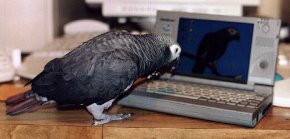
Timnehs are similar in looks to the larger red-tailed, or Congo greys, but with some remarkable differences. Timnehs are much smaller, weighing in at 275-375 grams. Their basic build is usually more slender. Their cages don’t have to eat your living room, and they fit well for apartment dwellers. Their upper beak is bone-colored instead of black, and their feathering is much darker than a Congo’s. Their tail feathers are a deep lustrous maroon. They have dainty little feet and a dainty little demeanor. Timnehs retain the white mask of their larger cousins, and many people find that their faces can be extremely expressive.
Their native home is in the countries on the southern coast of Africa’s western bulge. Their native landscape ranges from savanna to light forest. Red-tails live a bit further south, ranging from the coast deep into the interior of the continent.They prefer medium to heavy jungle and forest, although the ranges of the two birds do overlap.
This accounts for different behaviors on the ground. If you have never seen a Congo walk across your floor, he has a regal waddle. Timnehs, on the other hand, scoot. My Timneh Dickens loves to race under the dining room table, and run from chair leg to chair leg in a game of ‘Catch me if you can!’ She seems far more comfortable on the floor than my Congo does. Timneh’s are adept at hiding in plain sight. When one of my breeder pairs popped the latch on their cage, the male flew off when I entered to feed. He zipped down the hall,into the bedroom, then into the closet. How hard could it be to find him? More difficult than I thought, for he hunkered down in a shoe and only the blink of an eye revealed his whereabouts!

Timnehs in the wild eat a variety of things at various times of the year. Native nuts, grasses, seeds, sprouts and grubs are a major part of their diet. They opportunistically raid farms for corn, grains, peanuts that have been dug and are drying, and the nut and meat of the oil palm. In captivity they also thrive on variety. Breakfast here consists of sprouted seed from a company specializing in avian diets, frozen mixed vegetables (thawed), cooked brown and wild rice, cooked beans several times a week, chopped fresh vegetables, and chopped fruit in small quantities. To this is added a natural vitamin supplement. Later in the day this is replaced with a mixture of pellets and seed, one nut per bird (human grade walnuts or peanuts), and two or three small pieces of cheese per bird (mine seem to prefer Colby, jack, or jalapeno jack). Once in awhile they all get a small piece of hard-boiled egg yolk or cooked chicken or a Nutriberry. Some enjoy pasta, so when we have spaghetti I make sure there’s a little left for them. This sounds like a lot of food, but each item is fed in small quantities which match their appetites.
Timnehs usually love to eat. They thoroughly subscribe to the premise that if the food on top looks good, then the food beneath must be better! Consequently a lot of food gets tossed about. This can be somewhat controlled by using a larger, flatter food dish and spreading the food over a wider area before serving.
Timnehs need toys. They are very smart birds and without toys, they may resort to playing with their feathers. They love toys that clank, toys that shred, toys they can exercise their beaks on, toys that untie, and puzzle toys that present them with a challenge. Mirror cubes are a favorite here – they swing on them, clang the bell, and even roost on top. They show little apprehension about a new toy if you show it to them first. Paper towel tubes cut into 2 – 3 inch pieces and placed over the perches of a climbing tree keep Dickens busy for hours. So do small rolled-up newspaper balls and paper rolled into tubes. The best tip I ever received came from behaviorist Jane Hallander. A lock-down bowl placed in a corner of the cage and filled with foot-held toys, pieces of wood, strips of leather tied in knots, and parts of old toys provides opportunity for activity and a foraging experience. The occasional nut placed in the bottom provides a pleasant surprise.
Timnehs can read you like a book. They know if you have a headache, or if you are worried, and are quite empathetic. When you talk to them, they seem to understand you. If a human argument occurs, they worry about you until you tell them that everything is OK. If you connect with your Timneh, you have a life-long friend.
People often ask if Timnehs are as prone to feather-plucking as Congos. I truly don’t know. We collectively have seen a lot more Congos, so would see a lot more plucking Congos. I have a Timneh that shears her feathers off as soon as she becomes hormonal, and I have had a Timneh pluck because he badly wanted a mate. I suspect that in nature plucking seldom occurs, but we won’t know until comprehensive field study of these birds in their natural habitat is conducted.
Timneh Greys aren’t perfect, for they are prone to mischief, as most birds are. But for those who know and love them, they are as close to perfect as we can get.

